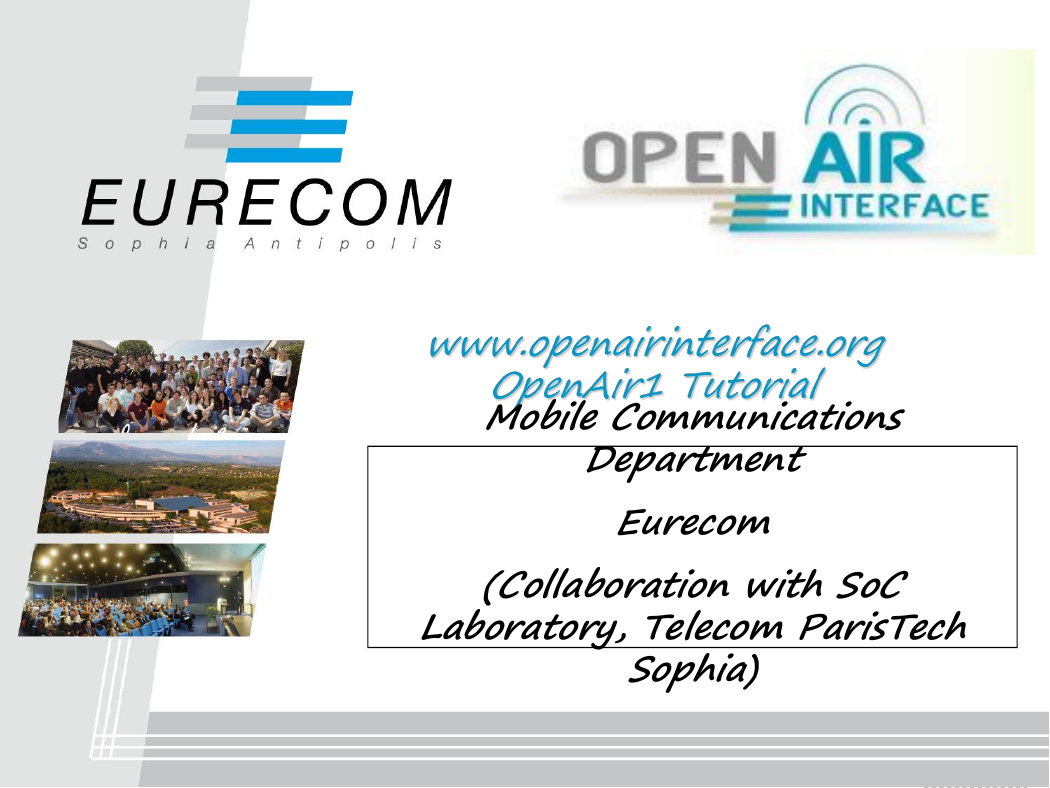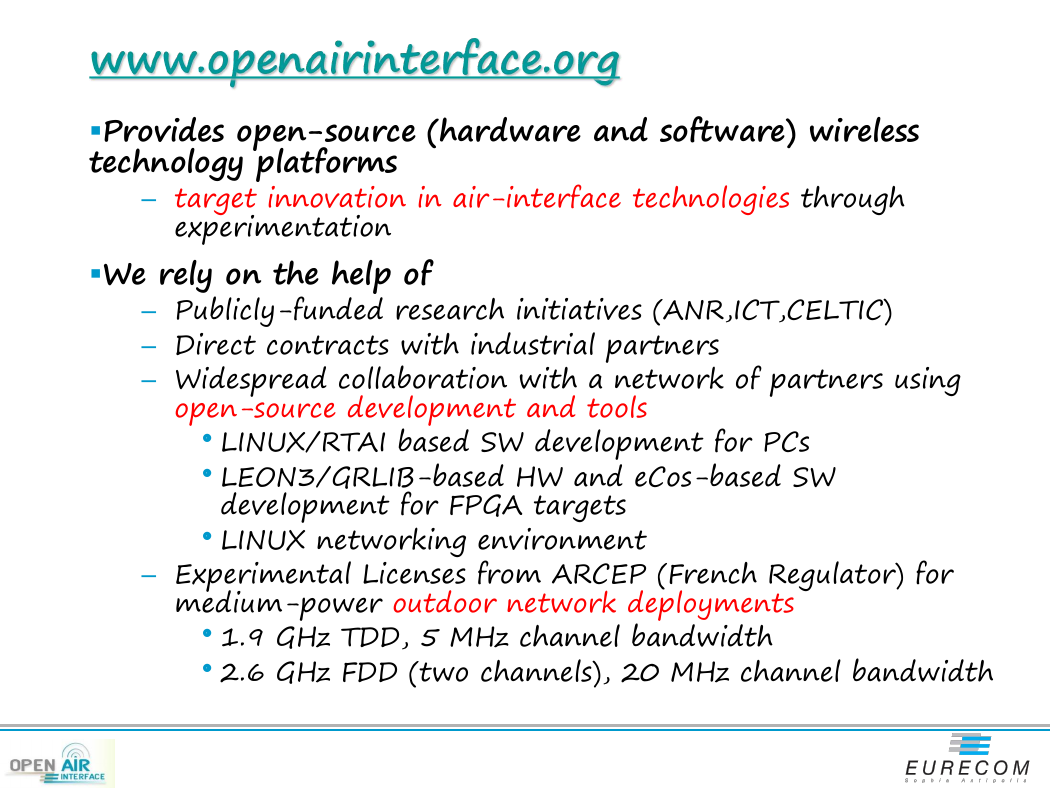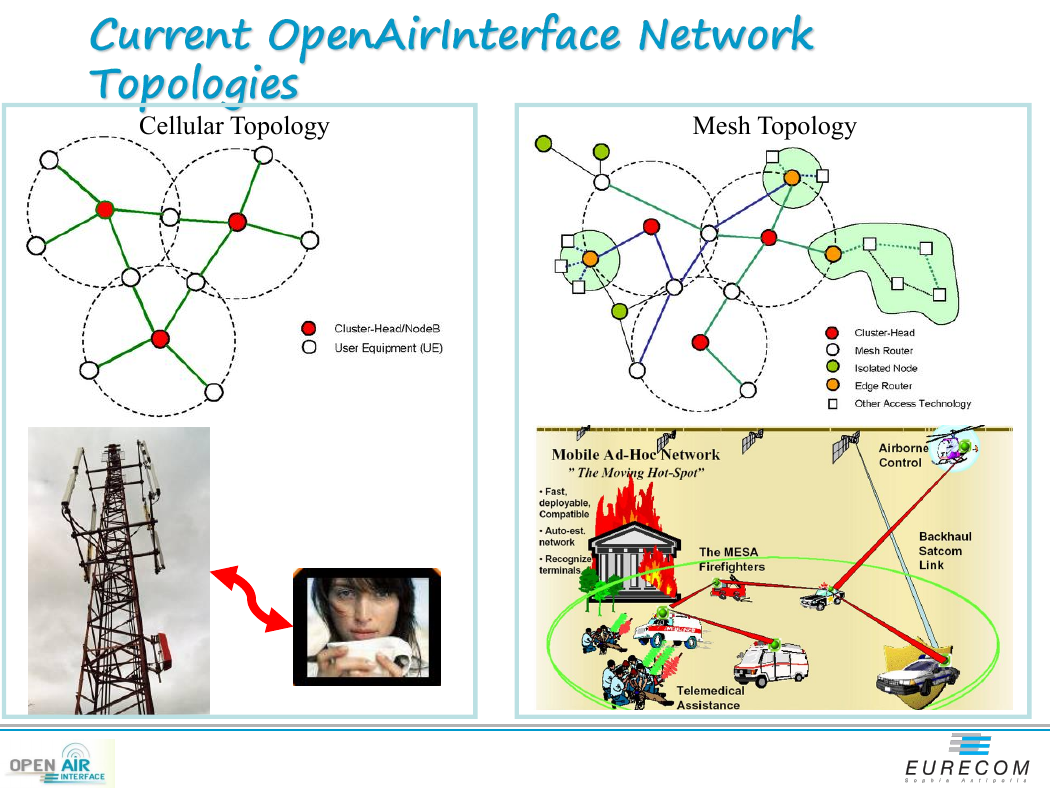Mobile Communications
Department
Eurecom
(Collaboration with SoC
Laboratory, Telecom ParisTech
Sophia)
�
§ Introduction to www.openairinterface.org
§ Current PHY/MAC Development
§ OpenAirInterface Simulation/Emulation Methodologies
�
§Provides open-source (hardware and software) wireless
technology platforms
– target innovation in air-interface technologies through
experimentation
§We rely on the help of
– Publicly-funded research initiatives (ANR,ICT,CELTIC)
– Direct contracts with industrial partners
– Widespread collaboration with a network of partners using
development for FPGA targets
open-source development and tools
hLINUX/RTAI based SW development for PCs
hLEON3/GRLIB-based HW and eCos-based SW
hLINUX networking environment
medium-power outdoor network deployments
h1.9 GHz TDD, 5 MHz channel bandwidth
h2.6 GHz FDD (two channels), 20 MHz channel bandwidth
– Experimental Licenses from ARCEP (French Regulator) for
�
Real-time Radio Signal Processing
– Hardware/software architectures in support of real-time signal processing (Software Radio,
multi-processor system-on-chip)
– Algorithmic optimizations at the PHY layer (UMTS-LTE and 802.16m technologies)
– PHY-layer support for cellular and mesh Network topologies
§ All-IP Wireless Networking
– All-IP Cellular mobile network protocols (IPv6 basestation routers, IPv6 mobility
– 802.21
–
–
management)
IP/MPLS Protocols adapted to MESH topologies
Layer 2 Protocols (MAC scheduling, Radio Resource Control, Radio Link Control) for cellular
and mesh network topologies
§
§
§
§ Agile RF System Design
–
–
Wideband radio design, linear wide-dynamic range receivers
"Intelligent" RF (RF/DSP co-design)
§ Design and Simulation Methodologies
etc.)
– Efficient simulation methods (performance, functional and behavioral)
– Abstraction techniques (hardware modelling, PHY sub-system modelling, traffic modelling,
– RF emulation architectures for distributed real-time simulation of wireless networks
Propagation and System Measurements and their Analysis (eMOS)
– Wideband channel characterization and modelling
– Real-time measurement collection and offline emipirical performance analysis
Cognitive Radio
– Development of innovative techniques based on sensor networks, that will support the
– Design, dimensioning and internetworking of cognitive networks
coexistence of licensed and unlicensed wireless users in a same area
�
§ OpenAirInterface SVN Repositories
– All development is available through
www.openairinterface.org’s SVN repository containing
hOPENAIR0 (open-source real-time HW/SW)
hOPENAIR1 (open-source real-time and offline SW)
hOPENAIR2 (open-source real-time and offline SW)
hOPENAIR3 (open-source Linux SW suite for cellular
– Partners can access and contribute to our development
and MESH networks)
§ OpenAirInterface TWIKI
– A TWIKI site for quick access by partners to our
development via a collaborative HOW-TO
§ Forum
– external support services (not currently used)
�
Cognitive
Technologies
Wideband RF,
Agile Spectrum
Management,
Interference
Management
and Control,
Distributed/Colla
borative
techniques,
Spectrum
Sensing,
Cognitive and
Flexible Radio
Architectures,
Ambient
Networking
OPENAIR3 : Wireless Networking
All-IP, Mobility Management, 802.21,
Cellular/Mesh Routing Protocols, Mesh Topology
Management, Multimodal Radio Resource
Management
OPENAIR2: Medium-Access Protocols
Cellular topologies, single-frequency resource
allocation, cross-layer wideband scheduling, Mesh
topologies, distributed resource control
OPENAIR1: Baseband/PHY
Advanced PHY (LTE/802.16x), Propagation
Measurement and Modelling, Sensing and
Localization Techniques, PHY Modeling Tools
OPENAIR0: Wireless Embedded System Design
Agile RF design, Reconfigurable High-end Transceiver
Architectures, FPGA prototyping, Simulation Methodologies,
Software development tools, low-power chip design
�
Cellular Topology
Mesh Topology
�
CBMIMOI – V1
ExpMIMO-lite
AgileRF/Express MIMO
CBMIMOI – V2
PLATON/RHODOS
2004
2006
2005
2003
2007
2008
2009
AdHoc/Mesh and Cellular
Topologies
FPGA-SoC (Virtex 2)
2x2 OFDM(A) @ 2 GHz,
5MHz channels
Cellular (towards LTE)
Cellular Systems
Pure Software Radio
WCDMA-TDD
All-IPv4/v6
2012
2010 2011
2013
Cellular, AdHoc and P2MP
Topologies
FPGA SoC (Virtex 5)+
Interface for partner
Processing Engines
Agile Tuning module (0.2 –
7 GHz)
Maximum Channel BW 20
MHz
OFDM(A)/WCDMA
�
















 2023年江西萍乡中考道德与法治真题及答案.doc
2023年江西萍乡中考道德与法治真题及答案.doc 2012年重庆南川中考生物真题及答案.doc
2012年重庆南川中考生物真题及答案.doc 2013年江西师范大学地理学综合及文艺理论基础考研真题.doc
2013年江西师范大学地理学综合及文艺理论基础考研真题.doc 2020年四川甘孜小升初语文真题及答案I卷.doc
2020年四川甘孜小升初语文真题及答案I卷.doc 2020年注册岩土工程师专业基础考试真题及答案.doc
2020年注册岩土工程师专业基础考试真题及答案.doc 2023-2024学年福建省厦门市九年级上学期数学月考试题及答案.doc
2023-2024学年福建省厦门市九年级上学期数学月考试题及答案.doc 2021-2022学年辽宁省沈阳市大东区九年级上学期语文期末试题及答案.doc
2021-2022学年辽宁省沈阳市大东区九年级上学期语文期末试题及答案.doc 2022-2023学年北京东城区初三第一学期物理期末试卷及答案.doc
2022-2023学年北京东城区初三第一学期物理期末试卷及答案.doc 2018上半年江西教师资格初中地理学科知识与教学能力真题及答案.doc
2018上半年江西教师资格初中地理学科知识与教学能力真题及答案.doc 2012年河北国家公务员申论考试真题及答案-省级.doc
2012年河北国家公务员申论考试真题及答案-省级.doc 2020-2021学年江苏省扬州市江都区邵樊片九年级上学期数学第一次质量检测试题及答案.doc
2020-2021学年江苏省扬州市江都区邵樊片九年级上学期数学第一次质量检测试题及答案.doc 2022下半年黑龙江教师资格证中学综合素质真题及答案.doc
2022下半年黑龙江教师资格证中学综合素质真题及答案.doc